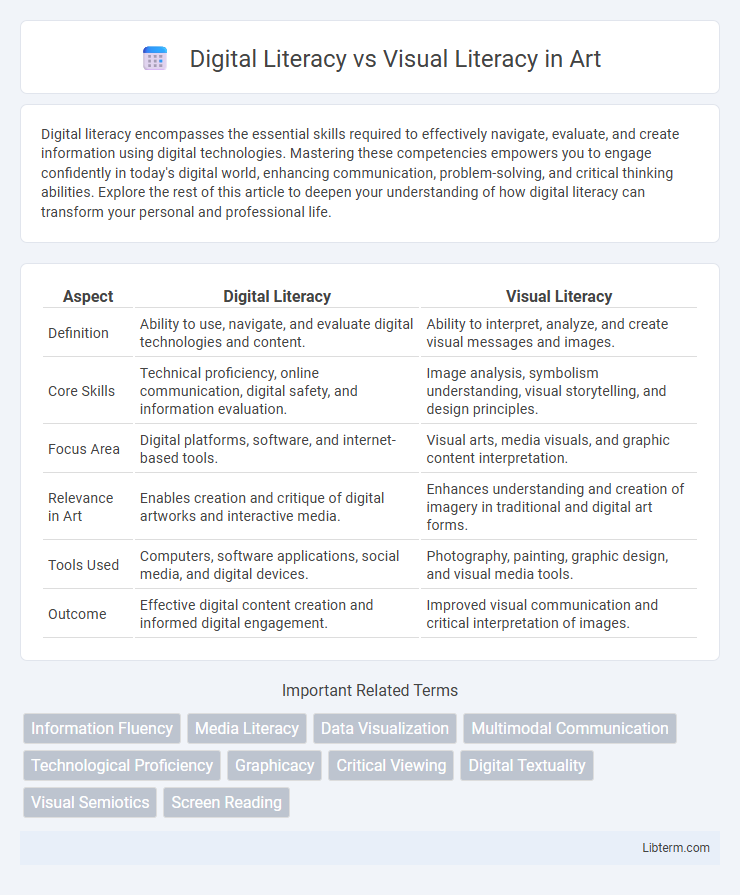Digital literacy encompasses the essential skills required to effectively navigate, evaluate, and create information using digital technologies. Mastering these competencies empowers you to engage confidently in today's digital world, enhancing communication, problem-solving, and critical thinking abilities. Explore the rest of this article to deepen your understanding of how digital literacy can transform your personal and professional life.
Table of Comparison
| Aspect | Digital Literacy | Visual Literacy |
|---|---|---|
| Definition | Ability to use, navigate, and evaluate digital technologies and content. | Ability to interpret, analyze, and create visual messages and images. |
| Core Skills | Technical proficiency, online communication, digital safety, and information evaluation. | Image analysis, symbolism understanding, visual storytelling, and design principles. |
| Focus Area | Digital platforms, software, and internet-based tools. | Visual arts, media visuals, and graphic content interpretation. |
| Relevance in Art | Enables creation and critique of digital artworks and interactive media. | Enhances understanding and creation of imagery in traditional and digital art forms. |
| Tools Used | Computers, software applications, social media, and digital devices. | Photography, painting, graphic design, and visual media tools. |
| Outcome | Effective digital content creation and informed digital engagement. | Improved visual communication and critical interpretation of images. |
Understanding Digital Literacy: Definition and Scope
Digital literacy encompasses the ability to effectively find, evaluate, create, and communicate information using digital technologies across various platforms and devices. It includes skills such as navigating software, understanding online safety, and critically interpreting digital content, essential for functioning in an increasingly digital society. This broad scope integrates technical proficiency with critical thinking to empower individuals to participate confidently and responsibly in digital environments.
Exploring Visual Literacy: Key Concepts
Visual literacy encompasses the ability to interpret, analyze, and create meaning from visual information such as images, symbols, and videos, essential for navigating today's media-rich environment. Key concepts include understanding visual design principles, recognizing visual rhetoric, and decoding cultural and contextual cues embedded in visuals. Developing visual literacy enhances critical thinking skills and enables effective communication across digital and traditional platforms.
Core Skills in Digital Literacy
Core skills in digital literacy encompass the ability to effectively search, evaluate, and use digital information across various platforms. These skills include critical thinking for discerning credible sources, understanding digital tools and technologies, and the ability to communicate and collaborate in online environments. Visual literacy, by contrast, emphasizes interpreting and creating visual content, but digital literacy provides a foundational skill set essential for navigating complex digital landscapes.
Essential Elements of Visual Literacy
Visual literacy encompasses the essential elements of design such as color, line, shape, texture, and space, enabling individuals to interpret, negotiate, and make meaning from visual information effectively. While digital literacy involves the ability to use digital tools and platforms proficiently, visual literacy specifically hones skills in critical observation, visual reasoning, and communication through images. Mastery of these elements enhances comprehension and expression in both traditional and digital contexts, bridging the gap between seeing and understanding visual content.
Overlapping Areas: Where Digital and Visual Literacy Meet
Digital literacy and visual literacy intersect in the ability to critically analyze, interpret, and create content across digital platforms. Both literacies emphasize understanding visual elements such as images, videos, and infographics combined with digital tools like software applications, social media, and multimedia editing. Developing skills in navigating digital environments enhances the capacity to decode visual information effectively, fostering comprehensive communication and information evaluation in modern contexts.
Importance of Digital Literacy in the Modern World
Digital literacy is crucial in the modern world as it enables individuals to effectively navigate, evaluate, and create information using digital technologies, fostering critical thinking and problem-solving skills essential for academic and professional success. Unlike visual literacy, which focuses on interpreting and understanding images and visual media, digital literacy encompasses a broader set of competencies including online communication, cybersecurity awareness, and digital content creation. Mastery of digital literacy empowers people to participate fully in the digital economy, access vast information resources, and engage responsibly in social and civic activities.
The Role of Visual Literacy in Media Consumption
Visual literacy enhances media consumption by enabling individuals to interpret and critically evaluate images, videos, and graphics across digital platforms. Unlike digital literacy, which emphasizes technical skills and navigation, visual literacy focuses on understanding visual messages, symbolism, and design elements that shape perception and influence decision-making. Mastery of visual literacy improves comprehension of complex media content, fostering informed and discerning audiences in an image-driven digital landscape.
Challenges in Teaching Digital and Visual Literacy
Teaching digital and visual literacy involves overcoming challenges such as rapidly evolving technology and diverse student access to digital tools, which create disparities in learning opportunities. Educators must also address the complexity of interpreting multimedia content alongside traditional text, requiring multifaceted instructional strategies. Balancing these demands while fostering critical thinking and media discernment skills is essential for effective literacy education in the digital age.
Strategies to Enhance Both Literacies
Strategies to enhance digital literacy include integrating interactive technology tools such as coding platforms, online research methods, and digital content creation workshops into educational settings. Visual literacy can be improved by teaching critical analysis of images, infographics, and multimedia presentations through exercises like media deconstruction and visual storytelling. Combining these approaches fosters comprehensive skills in navigating, interpreting, and producing digital and visual content effectively in the information age.
The Future of Literacy: Integrating Digital and Visual Skills
Digital literacy and visual literacy converge as essential skills for navigating the future's multimedia landscape, requiring proficiency in interpreting, creating, and critically assessing digital and visual content. Integrating these literacies enhances communication capabilities, enabling individuals to engage effectively with complex information across digital platforms and visual media. Emphasizing combined instruction in digital and visual literacy prepares learners for dynamic environments driven by technology and visual storytelling.
Digital Literacy Infographic

 libterm.com
libterm.com